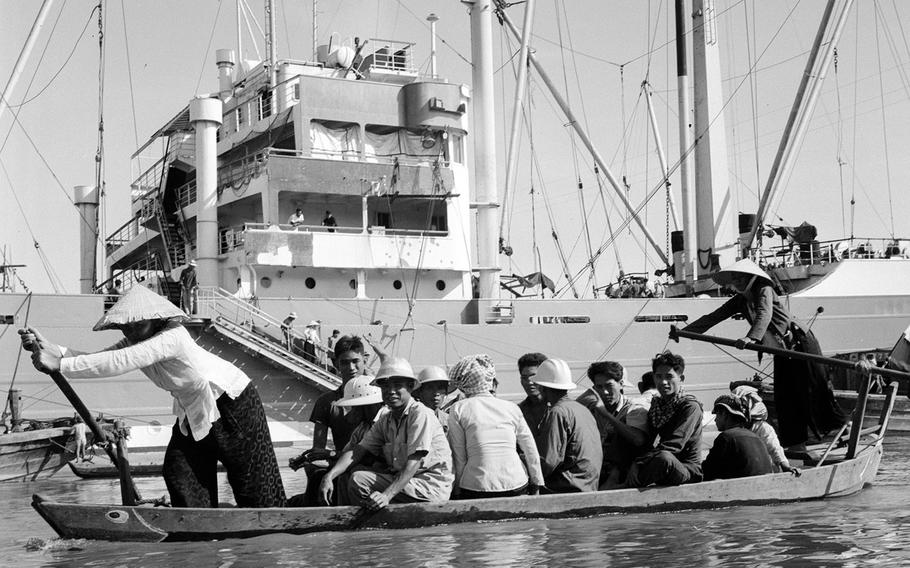
December, 1965: The passengers in this small boat crossing Saigon Harbor probably wished they could enjoy he roominess of the larger (and safer) craft in the background. (Jack Baird/Stars and Stripes)

December, 1965: The passengers in this small boat crossing Saigon Harbor probably wished they could enjoy he roominess of the larger (and safer) craft in the background. (Jack Baird/Stars and Stripes)
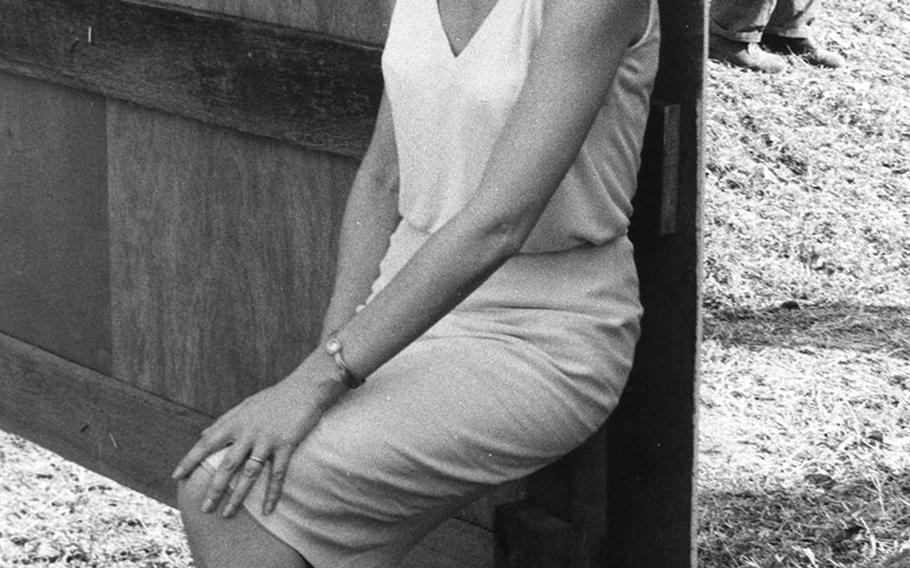
December, 1965: The sign probably wasn't posted with actress Carroll Baker in mind, but it served its purpose -- much to the chagrin of the servicemembers on the other side of the wall. Baker was touring the Far East with Bob Hope's annual Christmas show. (Ed Swinney/Stars and Stripes)
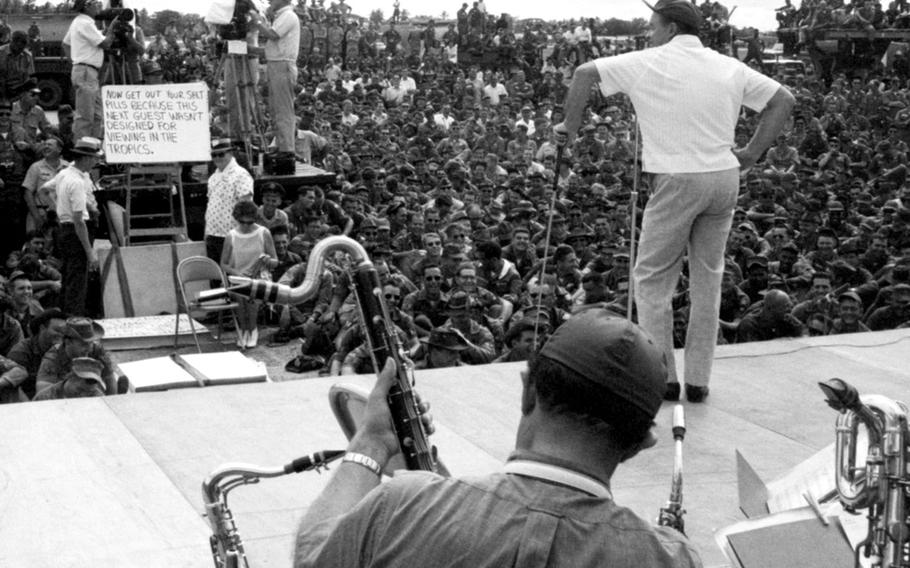
December, 1965: Bob Hope delivers a monologue during his annual Christmas show for U.S. troops. Hope was joined by a cast that included Carroll Baker and Kaye Stevens, singers Jack Jones and Anita Bryant, comedian Jerry Colonna, and Miss USA Dianna Lynn Batts. Maj. Ed Swinney, who took the photo, was Stars and Stripes' executive officer at the time; in his previous assignment, he handled logistics for Hope's annual tours. (Ed Swinney/Stars and Stripes)
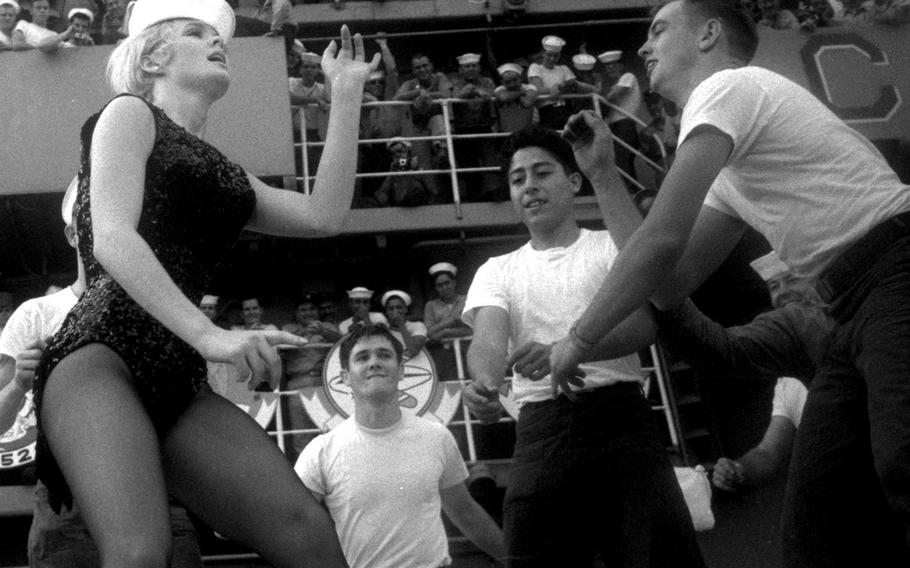
December, 1965: Singer-actress Joey Heatherton dances with sailors on the deck of the USS Ticonderoga, off the coast of Vietnam, during the annual Bob Hope Christmas tour of the Far East. (Gary Cooper/Stars and Stripes)
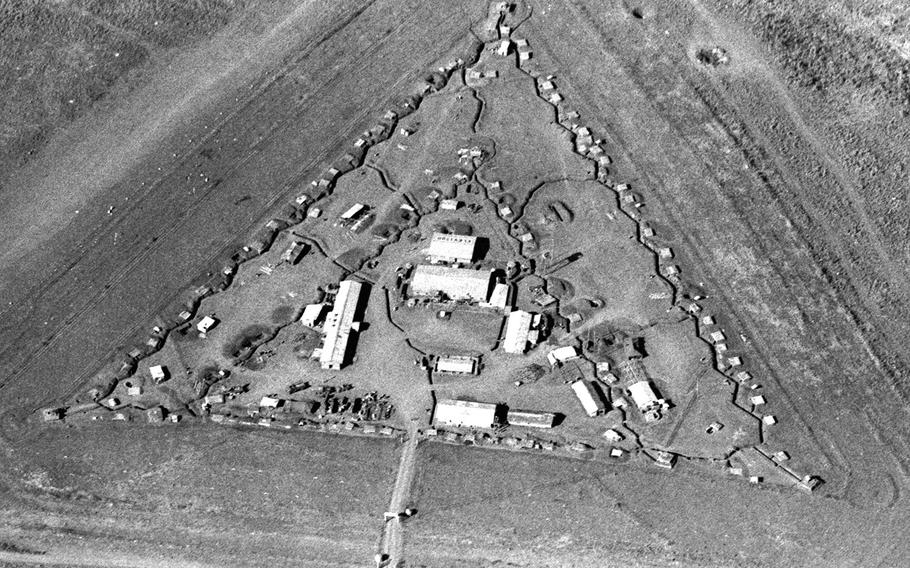
December, 1965: An aerial view of the Plei Me Special Forces camp where, in October, a handful of American troops and about 250 Montagnard tribesmen living nearby held off a Viet Cong attack until reinforcements arrived. (Joe Schneider/Stars and Stripes)
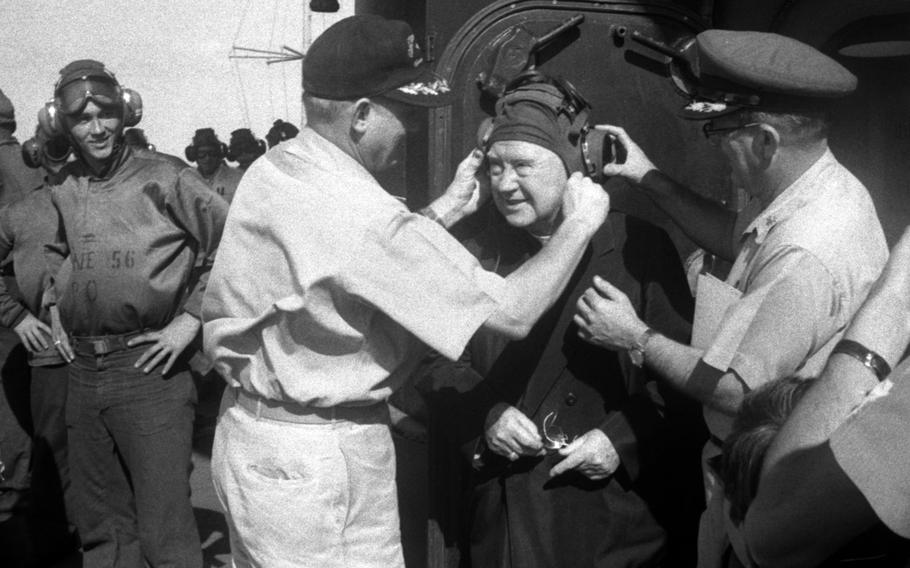
December, 1965: Francis Cardinal Spellman is fitted with appropriate headgear as he tours the deck of the USS Ticonderoga, off the coast of Vietnam, after arriving from Tan Son Nhut Air Base. Spellman, the Archbishop of New York and Apostolic Vicar for the U.S. Armed Forces, celebrated Mass in the ship's hangar bay, ate in the enlisted men's mess, and visited patients in sick bay during his visit. (Gary Cooper/Stars and Stripes)
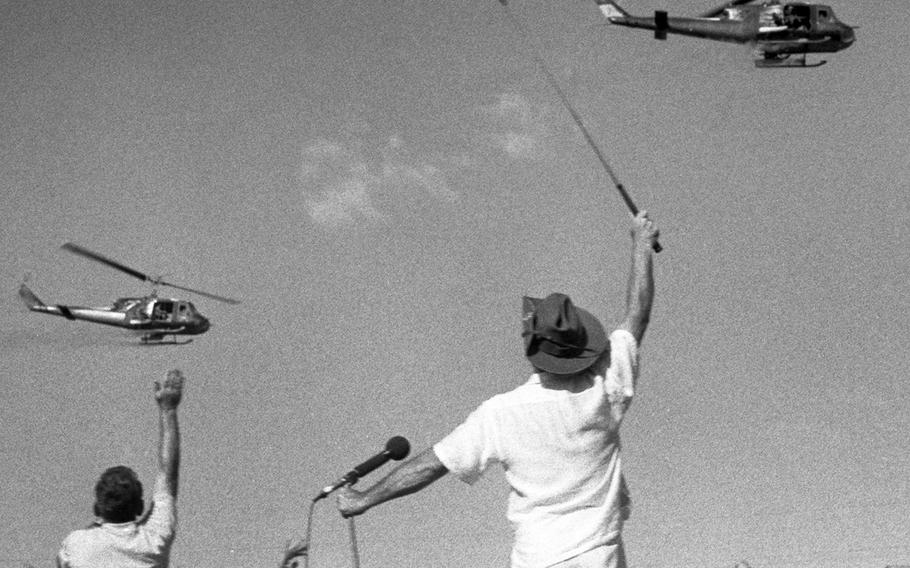
December, 1965: Bob Hope — with his trademark golf club — and members of his troupe wave to passing helicopters during a show at the Bien Hoa air base. (Gary Cooper/Stars and Stripes)
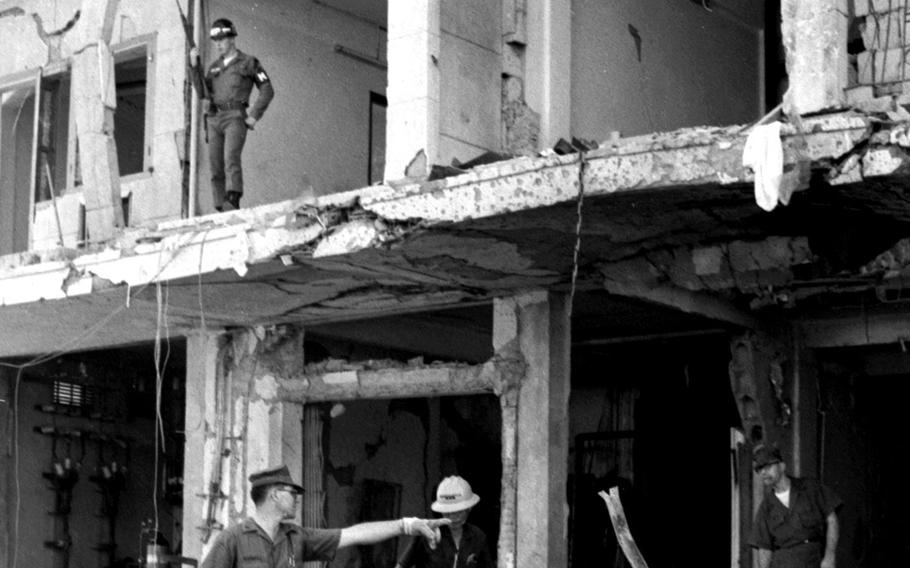
December, 1965: An MP stands guard on the devastated second floor of Saigon's Metropole Hotel as rescue efforts continue five hours after a truck bomb exploded outside the building, which served as a bachelor enlisted men's quarters for the U.S. military. Eight Vietnamese, one U.S. Marine and a soldier from New Zealand were killed in the early-morning blast that also injured more than 175 people, including 72 Americans. (Bob Cutts/Stars and Stripes)
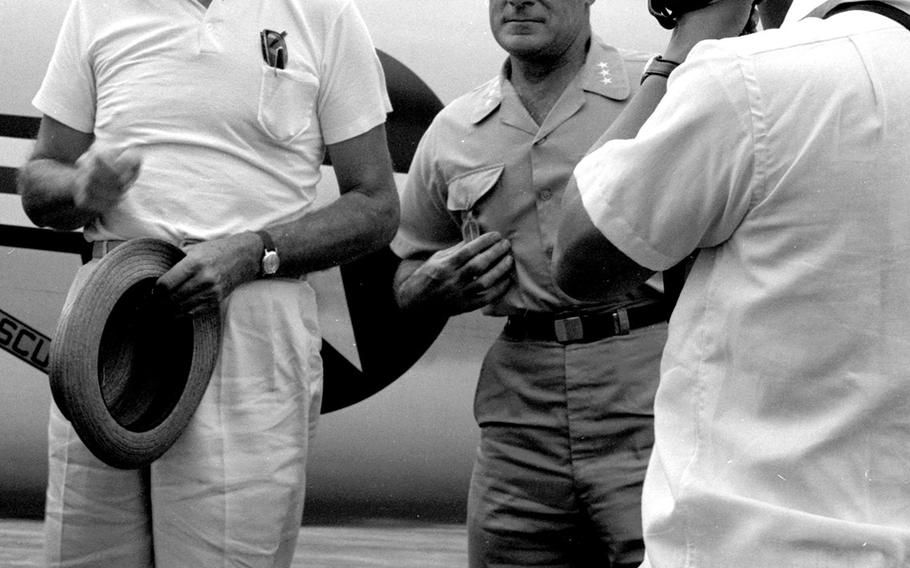
December, 1965: U.S. Ambassador to South Vietnam Henry Cabot Lodge, left, poses as he arrives aboard the USS Enterprise off the coast of Vietnam. Also visiting the world's first nuclear-powered aircraft carrier was South Vietnamese Prime Minister Nguyen Cao Ky. (Wally Beene/Stars and Stripes)
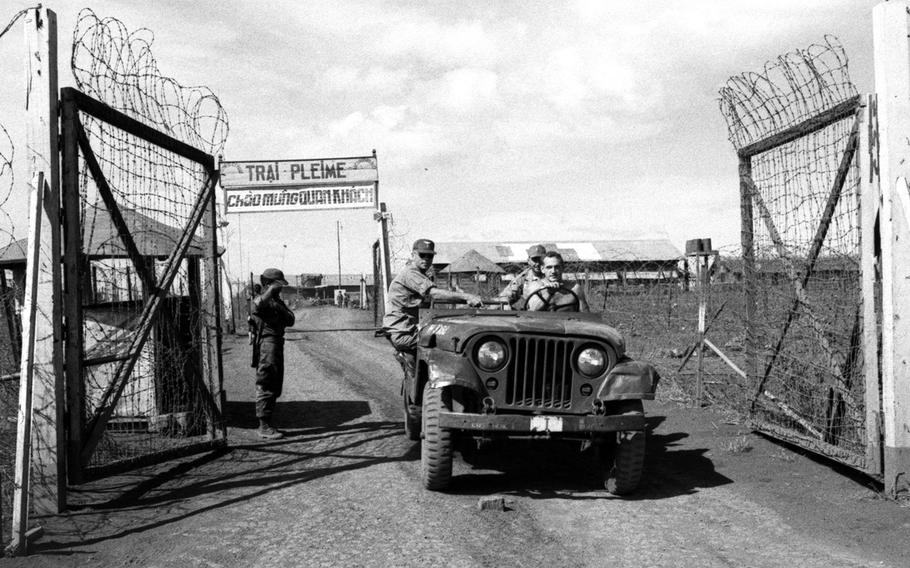
December, 1965: Servicemembers pass through the gate of the Plei Me Special Forces camp. Two months earlier, a handful of American troops and about 250 Montagnard tribesmen living nearby held off a Viet Cong attack on the camp until reinforcements arrived. (Joe Schneider/Stars and Stripes)

December 1965: Singer and comedienne Martha Raye, a friend and combat nurse to servicemembers from World War II through Vietnam, relaxes during a visit to the U.S. Navy berthing vessel Tourane Hilton in Da Nang Harbor. Raye — known as "Colonel Maggie of the Boondocks" for her frequent sojourns to entertain troops, notably Green Berets, in remote areas — was in the middle of a 14-show, eight-day tour of South Vietnam. Her dedication was officially recognized in 1966, when President Johnson made her an honorary lieutenant colonel; when she died in 1994, she was buried in the military cemetery at Fort Bragg, N.C. (Jack Baird/Stars and Stripes)
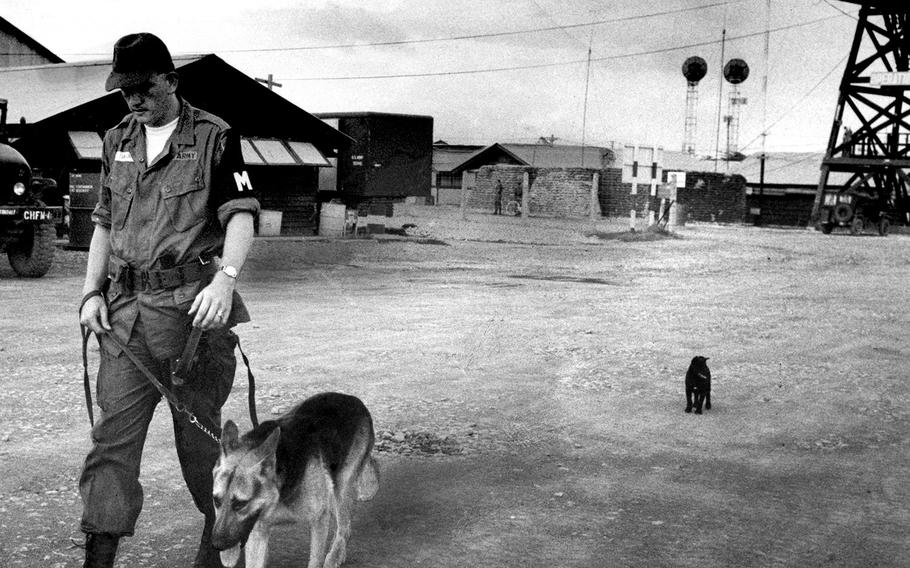
November, 1965: A military policeman and his dog are being followed as they patrol the tiny Vinh Long airfield, home of the U.S. Army's 114th Aviation Company, in South Vietnam's Mekong Delta region. (Bob Cutts/Stars and Stripes)
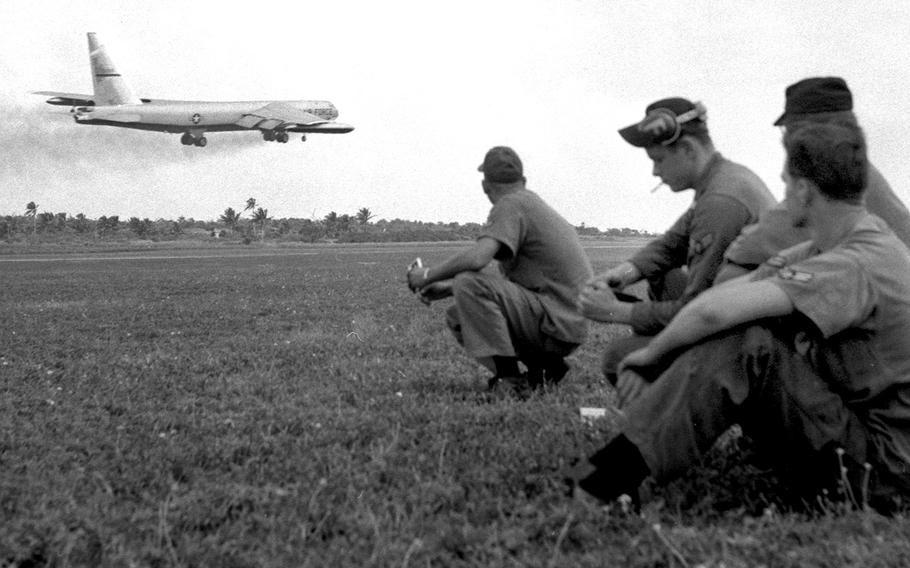
November, 1965: Their work done for the time being, members of the ground crew at Andersen Air Force Base, Guam, watch as a B-52 takes off on a bombing mission over suspected Viet Cong strongholds in South Vietnam. (Edward Benavente/Stars and Strip)
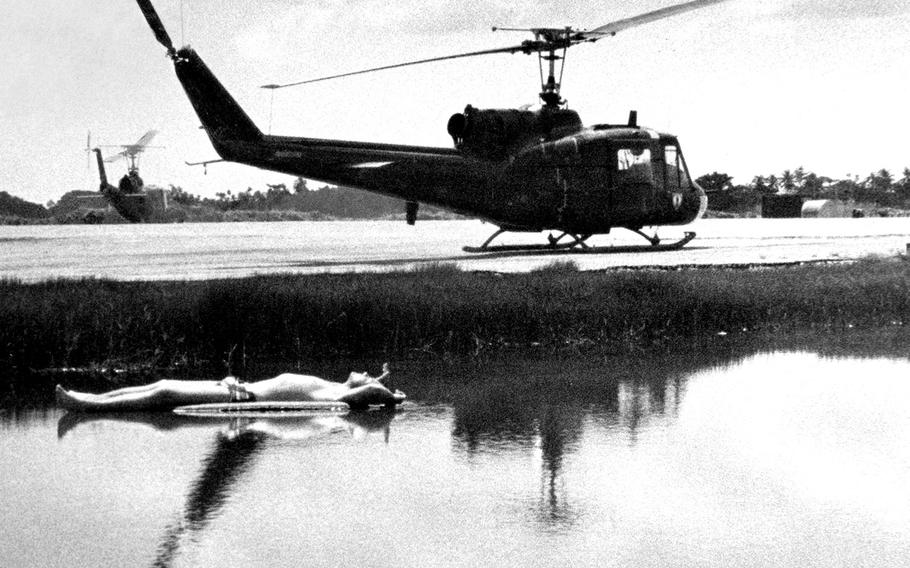
November, 1965: Warrant Officer Tom Allen soaks up some sun in a marshy pond near the flight line at the tiny Vinh Long airfield, home of the U.S. Army's 502nd and 114th Aviation Battalions, in South Vietnam's Mekong Delta region. (Bob Cutts/Stars and Stripes)
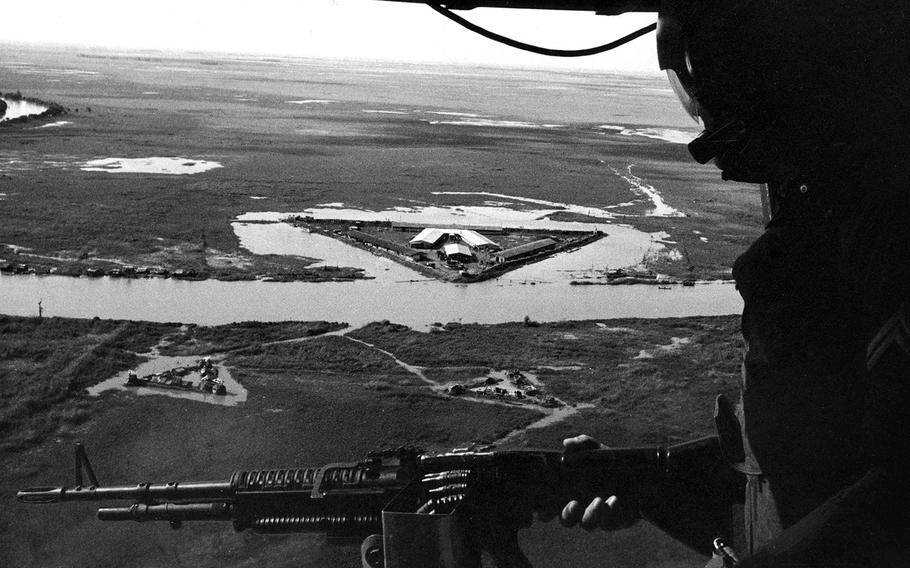
November, 1965: A crew member mans a machine gun in a helicopter circling a Special Forces camp in South Vietnam's Mekong Delta area. Copters brought soldiers and supplies to remote outposts from Vinh Long airfield, home of the U.S. Army's 502nd and 114th Aviation Battalions. (Bob Cutts/Stars and Stripes)
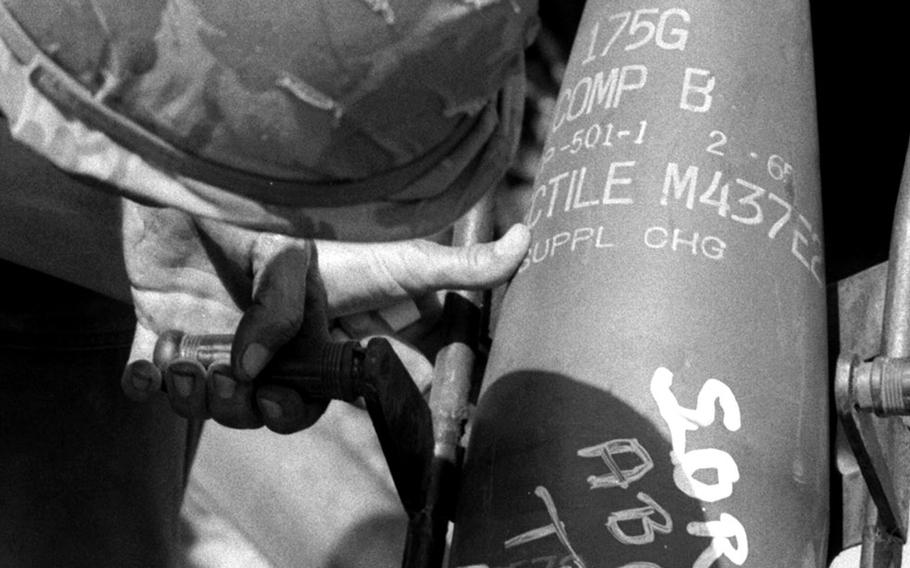
November, 1965: Brig. Gen. Charles M. Mount, assistant commanding officer of the 1st Infantry Division, scrawls a message for the Viet Cong on a shell that's about to be fired by one of the new 175-mm guns being used in Vietnam for the first time. The gun, one of several belonging to the 2nd Battalion, 32nd Artillery Brigade, 23rd Field Artillery Group, could fire a shell about 20 miles. (Bob Cutts/Stars and Stripes)
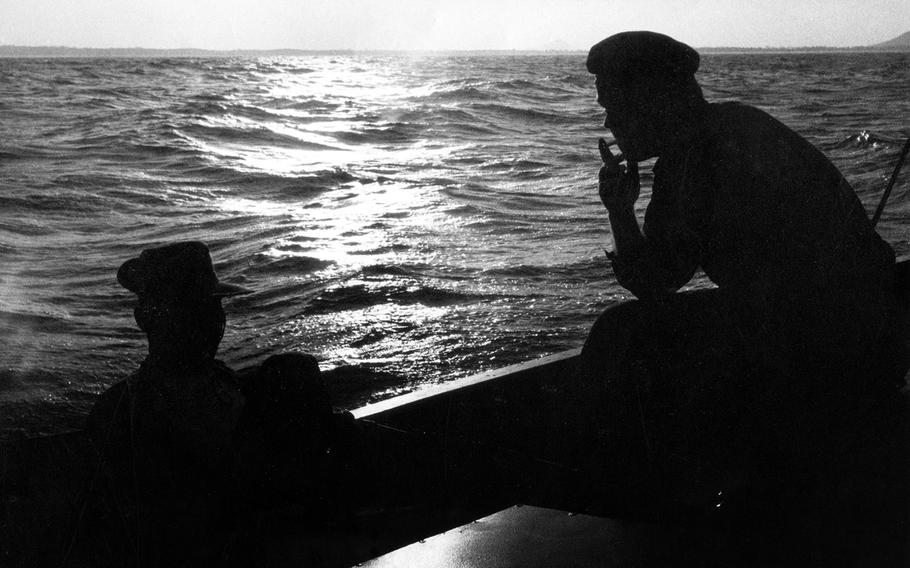
October, 1965: Lt. Harry Clock, left, and Lt. Cmdr. John Larson smoke and talk aboard a Vietnamese Navy patrol boat after a long day fighting the Viet Cong along the coast of central Vietnam. (Bob Cutts/Stars and Stripes)
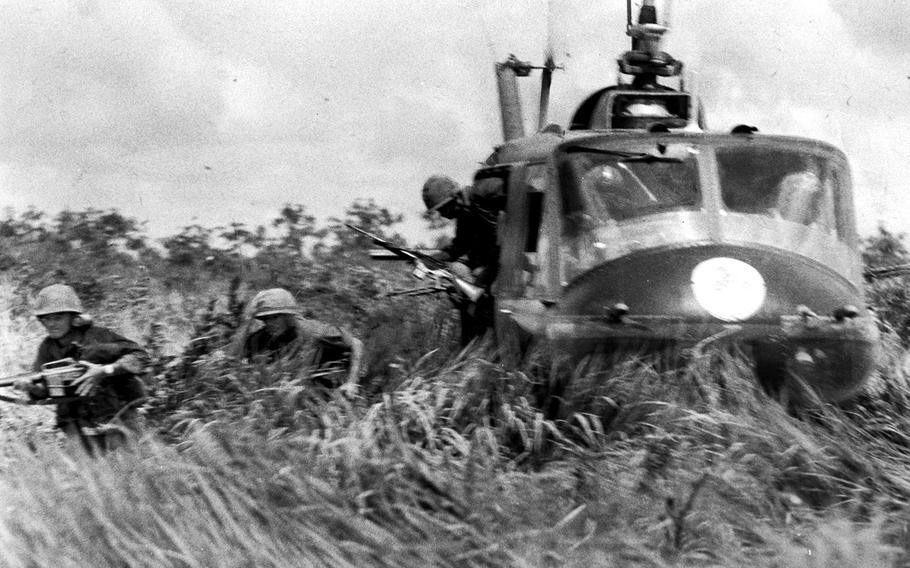
September, 1965: Soldiers from the 173rd Airborne Brigade's 1st Battalion leap from a helicopter during an Eagle Flight troop movement near the village of Plei Ya Bo. An Eagle Flight is a mission involving eight or more choppers, each carrying about nine infantrymen or Rangers. (Frank Waldrop/Stars and Stripes)
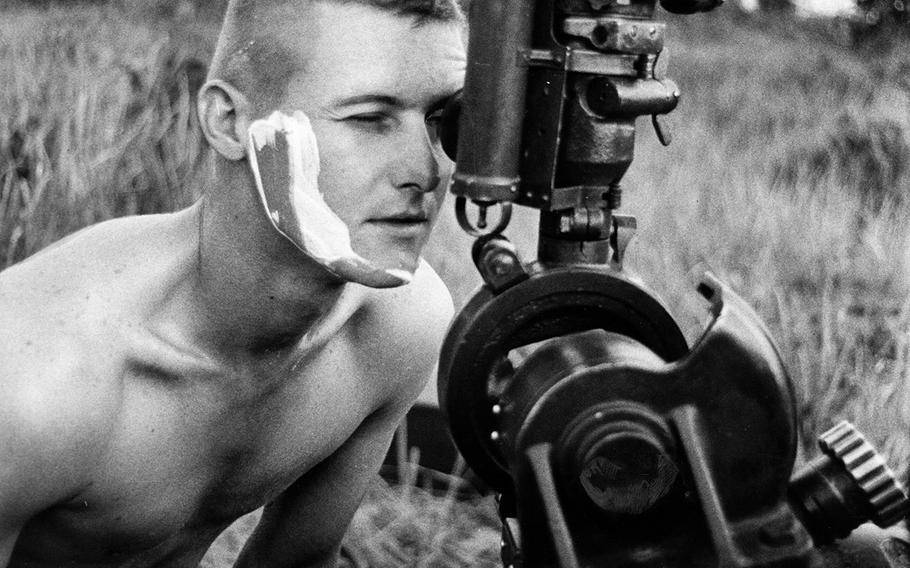
July, 1965: A fire mission caught Sgt. Homer Charnock of Bravo Battery, 319th Artillery, in the middle of shaving, so he dropped his razor and rushed into position to man his gunsight. (Bernard Carmichael/Stars and Str)
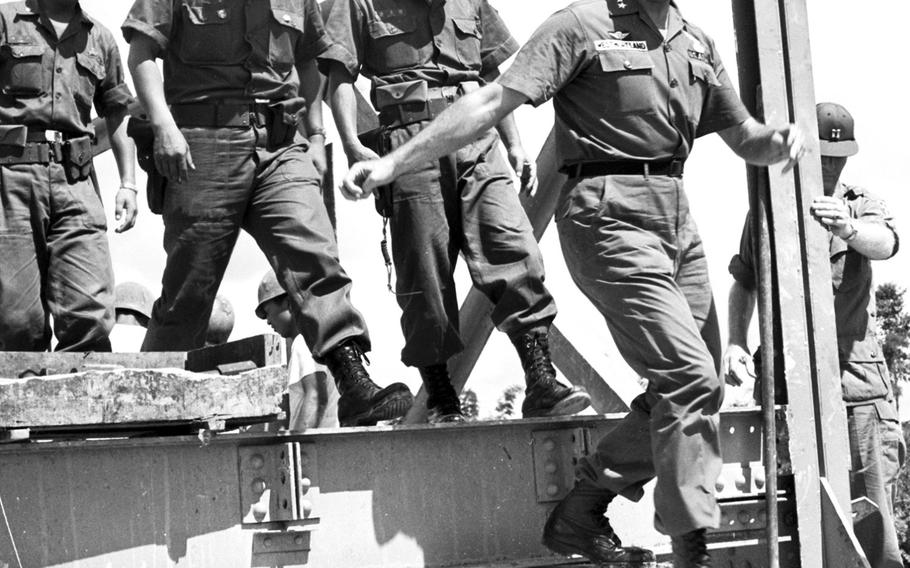
June, 1965: Gen. William Westmoreland, commander of U.S. forces in South Vietnam, jumps down from the end of a bridge being built by South Korean troops. On his tour of the area, Westmoreland also visited with Australian soldiers and Americans from the 173rd Airborne Brigade. (Mike Mealey/Stars and Stripes)
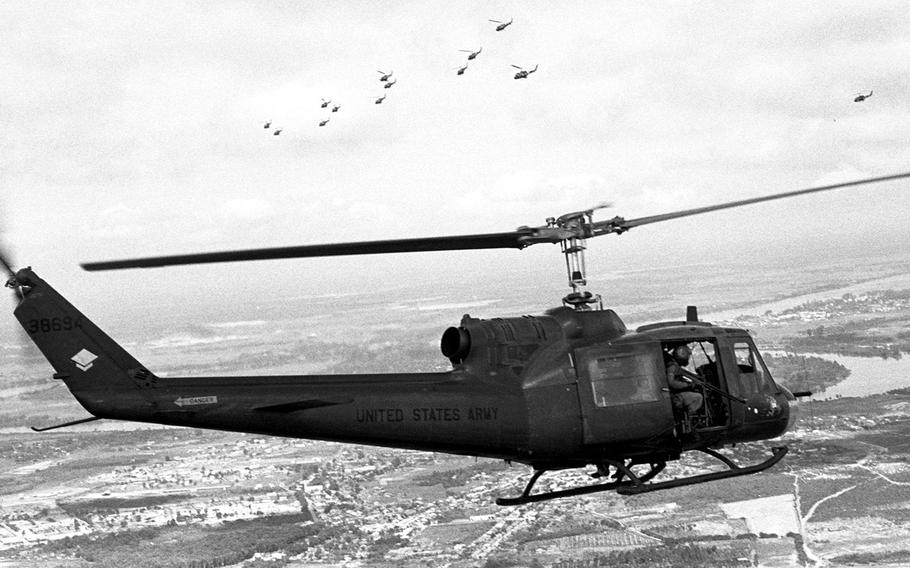
May, 1965: U.S. Army helicopters carry troops over the Vietnamese countryside near Binh Hoa. (Mike Mealey/Stars and Stripes)
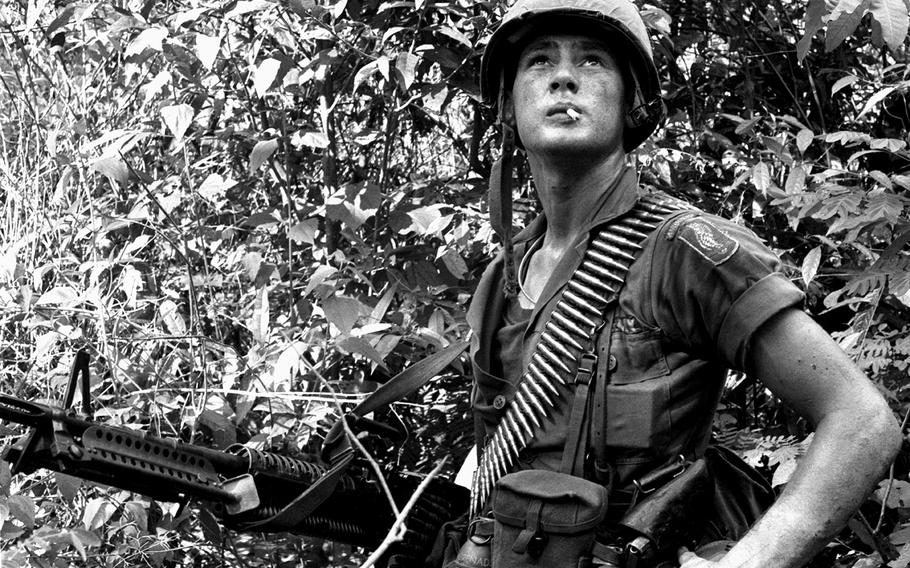
May, 1965: A soldier from the 173rd Airborne Brigade scans a clearing for signs of trouble during a jungle patrol out of Binh Hoa. (Mile Mealey/Stars and Stripes)
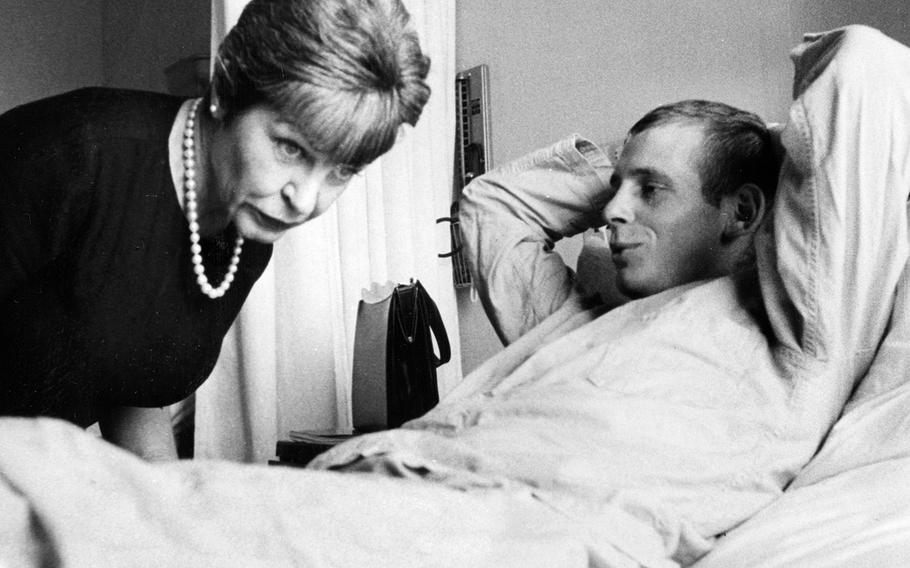
May, 1965: Comedian Martha Raye, in the Philippines on a USO tour, visits with Sgt. Richard Bartlett at the Clark Air Base Hospital. Bartlett, of Det. B, 1st Special Forces Group, suffered leg and neck wounds and lost his hearing in the battle at Song Be, South Vietnam. During the fighting, he played dead as he was stepped on and kicked by Viet Cong soldiers, one of whom used Bartlett's body to steady his rifle. (Stars and Stripes)
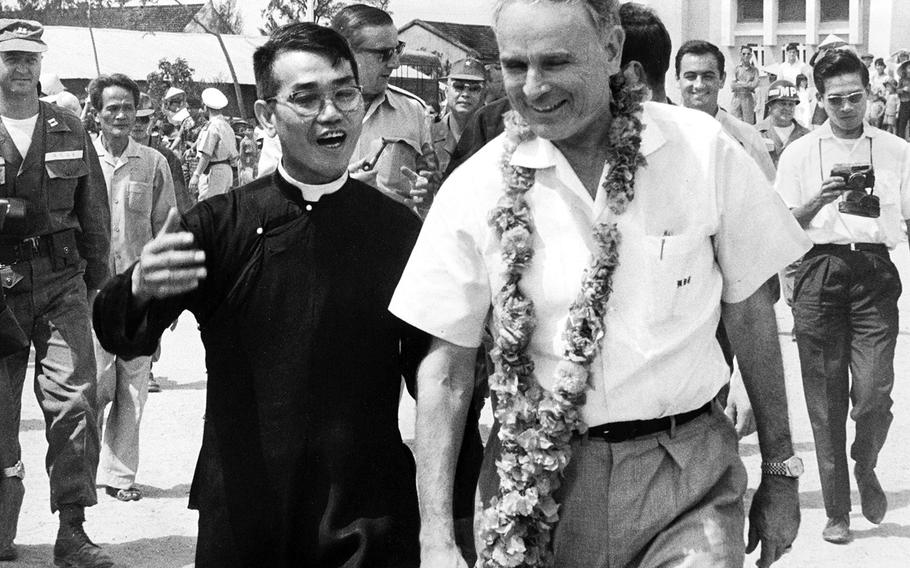
March, 1965: U.S. Ambassador to the Republic of Vietnam Maxwell D. Taylor chats with a Catholic priest as he tours a refugee center at Qui Nhon. Taylor, a World War II hero, served as chairman of the Joint Chiefs of Staff prior to his second retirement and appointment as ambassador. He was getting a firsthand look at the hardships faced by the 5,000 refugees who were forced to flee their villages by the Viet Cong. (Mike Mealey/Stars and Stripes)
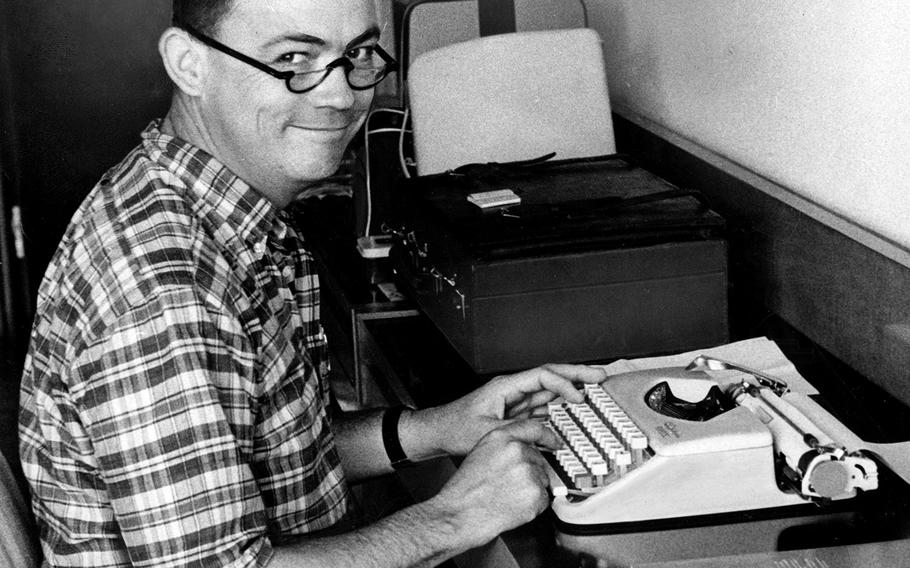
February, 1965: Bill Mauldin, who gained fame as a Stars and Stripes cartoonist during World War II, turns out copy in Saigon while covering his third war. Mauldin's reporting efforts for the Chicago Sun-Times placed him in the middle of a Viet Cong attack on the base at Pleiku, where he had also been visiting his son, Warrant Officer Bruce Mauldin. (Mike Mealey/Stars and Stripes)
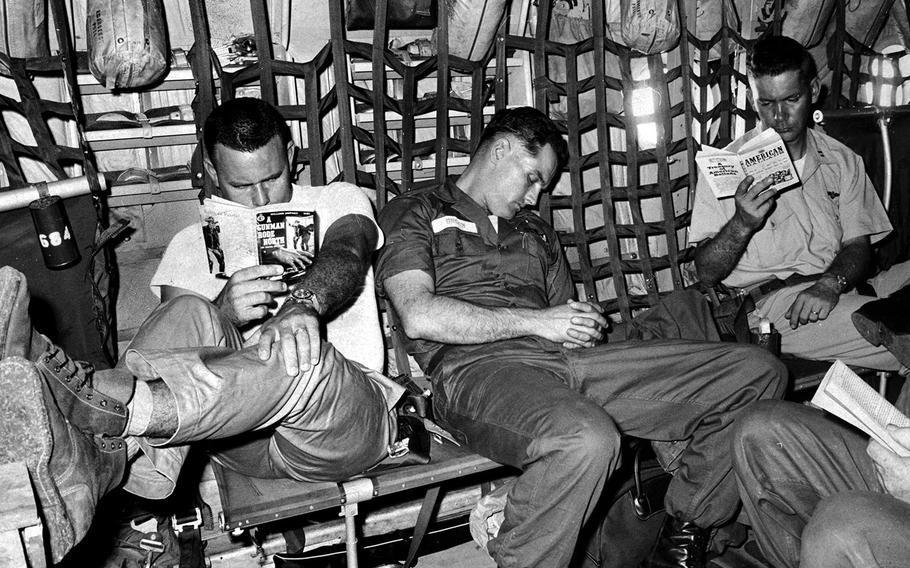
January, 1965: Passengers on this Marine flight from the Philippines to Vietnam didn't have to worry about returning their seats to an upright position before landing, but they did need to find ways to fight off boredom. (S.A. Morton/Stars and Stripes)
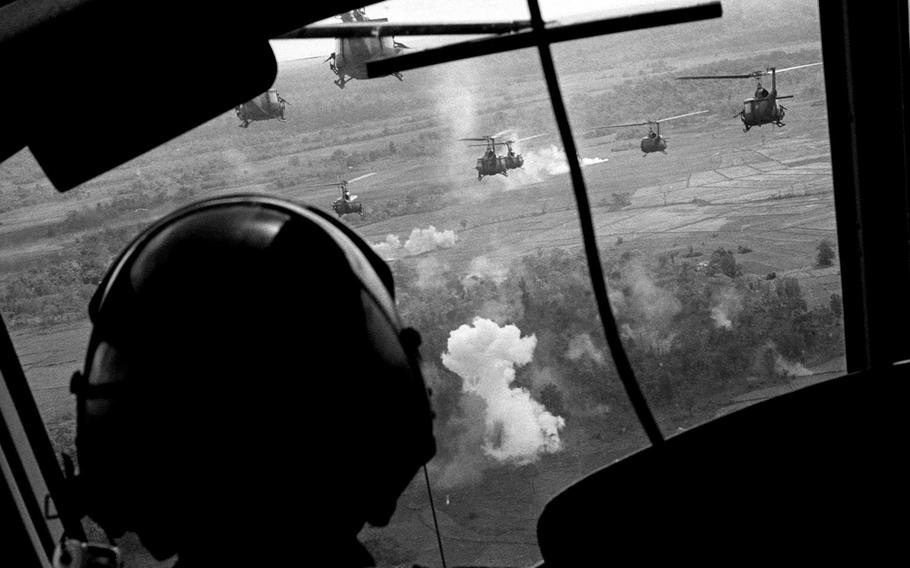
May, 1965: U.S. helicopters rake the perimeter of a landing zone with rockets and machine-gun fire before dropping off troops brought in from Binh Hoa. (Mike Mealey/Stars and Stripes)
A collection of photos taken by Stars and Stripes staffers in Vietnam in 1965.
Sign up to receive a daily email of today's top military news stories from Stars and Stripes and top news outlets from around the world.
